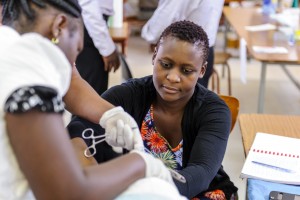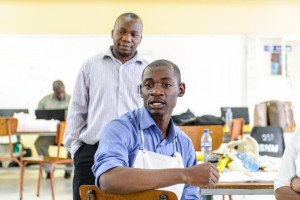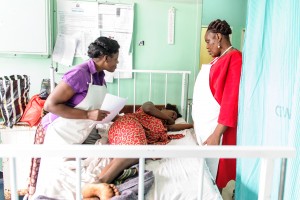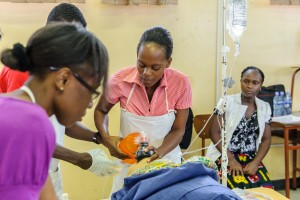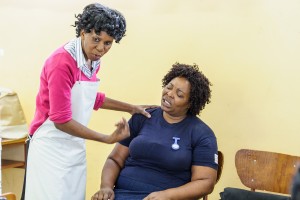In Ndola, Zambia on November 4, Patricia Munsanje and six other students huddled together around a dummy practicing cervical suturing. The students and their instructor—an obstetric health professional—bent down to carefully weave the sutures through a foam model meant to simulate a woman’s torn cervix after birth. First they practiced on the foam, and then applied their new skills to the dummy under the watchful eye of mentors as a part of a three-week training for rural health practitioners to gain and improve obstetric and neonatal-related skills. The program, Emergency Obstetric and Neonatal Care (EmONC) training, educates healthcare workers (HCWs) from around the country to respond to these medical emergencies in their own health facilities and communities.
This training program launched in 2013 to help address Zambia’s maternal, neonatal, and child health statistics. As recently as 2007, Zambia’s maternal mortality rate ranked as the 8th worst in the world, and neonatal mortality statistics were also alarming, Over half of all births occurred at home or without a skilled birth attendant (SBA) present, despite evidence indicating that SBAs (including doctors, medical licentiates, clinical officers, nurses, and midwives) practicing in or very close to the community could have a drastic impact on the reduction of maternal and newborn mortality.
 While Zambia has made some progress in improving maternal and under-five mortality, a lot of work remains. In particular, deliveries by SBAs have improved but the rate is still low at 64 percent. In an effort to further reduce these unnecessary deaths, the Government of Zambia has set ambitious targets, which will be achieved in part by increasing access to SBAs, among other interventions, including promotion of health-seeking behavior and improvement of nutritional standards.
While Zambia has made some progress in improving maternal and under-five mortality, a lot of work remains. In particular, deliveries by SBAs have improved but the rate is still low at 64 percent. In an effort to further reduce these unnecessary deaths, the Government of Zambia has set ambitious targets, which will be achieved in part by increasing access to SBAs, among other interventions, including promotion of health-seeking behavior and improvement of nutritional standards.
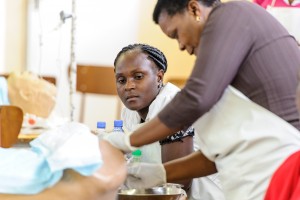 EmONC training makes a HCW a SBA by equipping them with skills to manage normal deliveries, as well as identify, manage, and refer complications in women and newborns. Since 2013, CHAI Zambia, with support from the UK Department for International Development (DFID) and the Swedish International Development Cooperation Agency (SIDA), has worked with the Government of Zambia and other partners to conduct in-service (EmONC) trainings for 221 HCWs. The HCWs trained include tutors, clinical instructors, and practicum site supervisors from target nursing, midwifery, and clinical officer training institutions, in order to enable them to pass on EmONC skills to pre- service and in-service students. In addition, some district level Mother and Child Health (MCH) coordinators and other HCWs from rural health facilities have been trained in EmONC.
EmONC training makes a HCW a SBA by equipping them with skills to manage normal deliveries, as well as identify, manage, and refer complications in women and newborns. Since 2013, CHAI Zambia, with support from the UK Department for International Development (DFID) and the Swedish International Development Cooperation Agency (SIDA), has worked with the Government of Zambia and other partners to conduct in-service (EmONC) trainings for 221 HCWs. The HCWs trained include tutors, clinical instructors, and practicum site supervisors from target nursing, midwifery, and clinical officer training institutions, in order to enable them to pass on EmONC skills to pre- service and in-service students. In addition, some district level Mother and Child Health (MCH) coordinators and other HCWs from rural health facilities have been trained in EmONC.
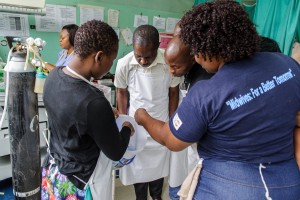 This three-week EmONC training session in Ndola included classroom-based theory, skills training and mentoring, and practical application of skills in the Ndola Central Hospital Maternity Ward. Six trainers, including one medical doctor, one medical licentiate, one anesthetist, and three midwives from around Zambia, worked closely with students to teach, monitor, and later evaluate them on some of the basic principles of emergency obstetric and neonatal care. Skills training sessions included manual removal of the placenta, suturing of cervical tears, adult and neonatal resuscitation, and breech delivery. The training also included twice-daily unexpected emergency drills that tested students’ ability to respond appropriately and without warning to urgent situations. Today, the drill simulated the arrival of a woman who had recently given birth and who required a manual placenta removal. After the conclusion of the drills, students and teachers discussed the positive and negative aspects of the response and what elements could have been improved. Students today also accompanied local midwife Matilda Somanje to the delivery ward of the hospital and practiced their skills in the crowded labor ward.
This three-week EmONC training session in Ndola included classroom-based theory, skills training and mentoring, and practical application of skills in the Ndola Central Hospital Maternity Ward. Six trainers, including one medical doctor, one medical licentiate, one anesthetist, and three midwives from around Zambia, worked closely with students to teach, monitor, and later evaluate them on some of the basic principles of emergency obstetric and neonatal care. Skills training sessions included manual removal of the placenta, suturing of cervical tears, adult and neonatal resuscitation, and breech delivery. The training also included twice-daily unexpected emergency drills that tested students’ ability to respond appropriately and without warning to urgent situations. Today, the drill simulated the arrival of a woman who had recently given birth and who required a manual placenta removal. After the conclusion of the drills, students and teachers discussed the positive and negative aspects of the response and what elements could have been improved. Students today also accompanied local midwife Matilda Somanje to the delivery ward of the hospital and practiced their skills in the crowded labor ward.
Dr. Allan Musonda, the lead trainer of this EMONC training session who is an obstetrician based in the capital city of Lusaka, noted that the training prepares attendees to be team leaders at their home facilities across the country in order to teach others these essential skills. “Those who are trained really make an impact in reducing maternal and neonatal mortality,” he said.
Patricia Munsanje, a midwife from Lewanika General Hospital in Zambia’s Western Province traveled for hours to participate in the training. “This training is so beneficial and will be so helpful,” she said. “It makes me feel more confident as a provider and will benefit my community.” In the referral hospital where she serves as a midwife, there are more than 20 births per day, and complicated cases from around the remote province are referred there for treatment. Especially given this large number of deliveries, she plans to share the knowledge and skills she gained during the EMONC training with her peers back in Western Province.
In 2014 and 2015, CHAI provided financial and technical assistance to the Ministry of Health to review Nursing, Midwifery and Clinical Officer curricula, in order to strengthen EmONC components of the curricula. Through curricula reviews, capacity building, health training institution infrastructure development, and other interventions, CHAI-implemented programs will support the Government of Zambia to train 2,993 new ‘mid‐level’ SBAs. The programs will also strengthen systems for supportive supervision and mentorship of SBAs post‐graduation in target provinces, and collect evidence to inform government policy decisions to improve rural retention.





